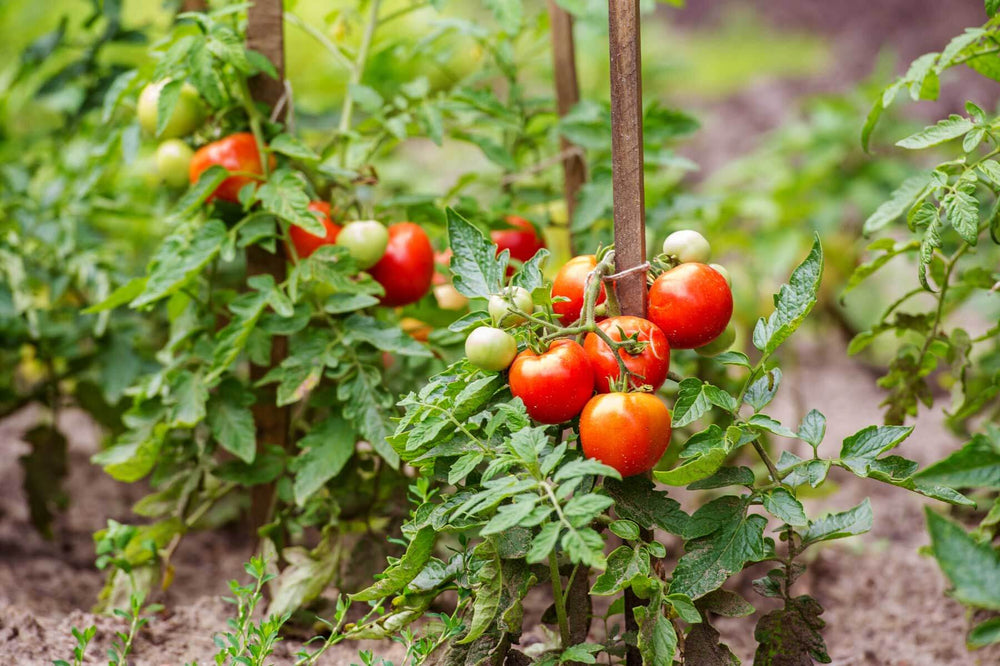Tomato plants benefit from support, whether you use tomato cages, stakes, or a myriad of other creative solutions. Choose one of these methods to keep them off the ground.
Stake or support tomatoes off the ground to:
- Avoid diseases
- Make it easier to harvest
- Keep fruit clean
- Make it easier to spray and monitor problems
Stakes
This simple support only requires driving a stake into the ground by each plant and tying the plant up the stake as it grows. Stakes for indeterminate varieties need to be 6 to 8 feet tall with a foot or so in the ground for stability. You can buy wooden, plastic, and bamboo tomato stakes, or you can fashion your own from pipe or other salvage materials.
Drive the stake beside the plant when you set it out. If you wait, don't wait long, because you could hurt the roots. Tie the main stem to the stake loosely with soft ties to avoid injuring the stem. Eight-inch strips of panty hose are ideal.
- Set stakes 2 to 4 feet apart, depending on the size of your tomato variety.
- Stakes are easy to take up at the end of the season.
Tomato Cages
Caging tomatoes doesn't require as much tying because the sides of the cage support the stems. You can buy wire tomato cages, although they are often not big enough for indeterminate varieties.
You can make a large tomato cage that lasts for years with 5-foot, 10-gauge concrete reinforcement wire with 6-inch openings. Cut a 4 1/4-foot length of the wire and coil it to make a circular cage about 18 inches in diameter. Cut off the bottom two levels of horizontal wire to create "legs" which you can push into the ground to hold the tomato cage in place. When caging tomatoes in windy areas, it helps to drive a couple of sturdy stakes into the ground on opposite sides just inside the cage; fasten these to the cage for extra stability. Plant one tomato inside the cage and pull the stems through the wire as they grow for support.
- Set cages 4 feet apart, depending on the size of your tomato variety.
- Cages are easy to take up at the end of the season.
Wire Trellis
A wire trellis is a combination of the two techniques above. To build the trellis, sink poles or 4-inch wooden posts into the ground about 10 feet apart. Be sure that they are deep enough and properly anchored to support the weight of all the tomatoes when laden with fruit. The tops of the posts should be 5 or 6 feet high. Staple or tie concrete reinforcement wire or wire fencing with 6-inch openings to the posts. You can leave a space of about a foot from the bottom of the wire to the ground; it should be high enough that your tiller can clear underneath.
Plant the tomatoes along the length of the trellis 3 to 4 feet apart. Train the stems to wind through the trellis, tying them occasionally when needed. The trellis should last several years, but you might want to rotate the tomatoes with beans and cucumbers to avoid problems with a buildup of insects and diseases. Unlike the other two staking methods, the wire trellis is not mobile.
Permanent Trellis
Some gardeners make permanent trellises from rebar welded in a tall rectangular shape. It is heavy enough to stay in place and is sculptural even when it sits empty in the winter. These are obviously a bit of work up front, and you need welding skills and tools, but if you have them available, this is a handsome choice.




 Herbs
Herbs
 Vegetables
Vegetables
 Fruit
Fruit
 Flowers
Flowers
 Succulents
Succulents


